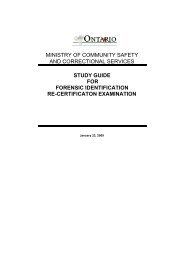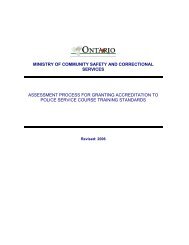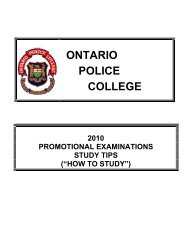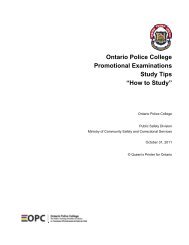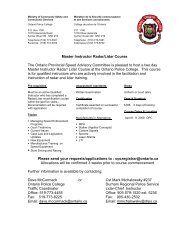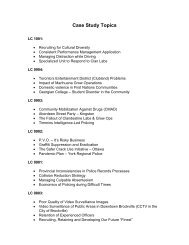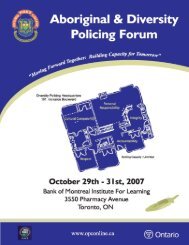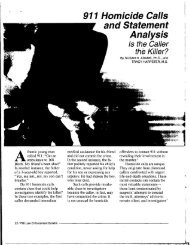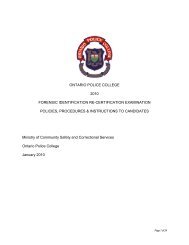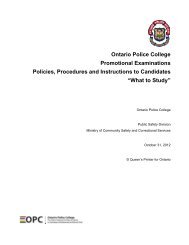General Study Guide - Ontario Police College
General Study Guide - Ontario Police College
General Study Guide - Ontario Police College
You also want an ePaper? Increase the reach of your titles
YUMPU automatically turns print PDFs into web optimized ePapers that Google loves.
4. Silver Physical Developer (Ag-PD) (1975)<br />
Pre-wash with maleic acid (10 min. or until bubbles<br />
disappear.)<br />
Specimen is immersed up to 20 min. & item s/b<br />
agitated (gentle rocking motion).<br />
Post-wash in 3 separate distilled water baths for ~ 5<br />
min. each before re-processing.<br />
Grey<br />
Chemical reaction with lipids, fats, oils<br />
and waxes in print residue.<br />
At present, no reagent has been as<br />
successful as the Ag-PD for visualizing<br />
the water-insoluable components of<br />
latent print residue (fats and<br />
oils/lipids, proteins) on paper.<br />
Photograph.<br />
* In their classes, the FBI is teaching a new method of using iodine. By mixing it with solvents and spraying it on papered or painted walls or paper<br />
documents, latent prints are being developed which last several hours. Therefore, photography of latent prints developed using Liquid Iodine need not be<br />
immediate. This method of spraying Liquid Iodine can be used at crime scenes if protective measures are taken. Iodine fumes are toxic & corrosive. Every<br />
precaution should be taken to avoid inhaling iodine fumes. A full-face, self contained breathing apparatus and protective clothing such as coveralls and<br />
gloves must be worn. CAUTION: The mixing and spraying of this solution must be done in a fume hood or while using a full-face breathing apparatus.<br />
** Physical Developer (used immediately after item has been dryed and fluorescence examination) is especially successful in developing latent prints on<br />
porous substrates that were previously wet. (Refer to Figure 5.8, pg.187, A.F.T. Flowchart for fingerprint visualization on paper and cardboard.) Sodium<br />
hypochlorite can also be used post-PD on porous, previously wet items. PD also works well on clay fire bricks, concrete, latex or rubber gloves, both sides<br />
of adhesive tape, rayon or nylon clothing, unfinished porcelain, unfinished wood and wooden knife handles.<br />
***Thermal and Carbonless Papers are used for many current business applications and therefore “a fundamental understanding of its chemical and<br />
physical properties is required to assist the examiner in deciding what possible method of chemical processing will not damage these specialty papers,<br />
while subsequently allowing for the development of quality friction ridge detail on their surface.” (Jon T. Stimac, Journal of Forensic Identification, Vol.53,<br />
Issue 2, 2003) Refer to separate article on Latent Print development on Thermal Paper in this study guide.



